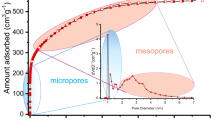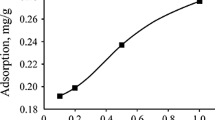Abstract
The effect produced by the treatment of wasted activated carbons with chlorine dioxide on the restoration of the adsorption capacity of sorbents resided for a long time in the adsorbers incorporated into the tap water post-treatment system of a beverage production plant was investigated. The studies were performed by treating the carbon samples with chlorine dioxide solutions of different concentration, steaming at a temperature of 150°C, and combining the treatment with oxidant solutions and steaming on the laboratory bench. The structural and sorption characteristics of carbons were calculated according to the Langmuir and Freundlich models, and the iodine number of the studied samples was also determined. It has been shown that the combination of oxidative treatment with chlorine dioxide and the steaming of activated carbon provides not only the sanitation of the sorbent in an industrial adsorber, but also the restoration of the structural and sorption properties of carbon. The series of performed experiments can restore the adsorption capacity of activated carbon to ~75–85% of the initial level. The degree of restoring the adsorption capacity of sorbents depends on the time of load operation in the adsorption filters. Depending on the time of carbon operation in an adsorber, the microporous space of the sorbent can be completely or partially purified. This fact plays an important part in the removal of organochlorine compounds formed during the final disinfection of water.


Similar content being viewed by others
REFERENCES
Pan, L., Takagi, Y., Matsui, Y., Matsushita, T., and Shirasaki, N., Micro-milling of spent granular activated carbon for its possible reuse as an adsorbent: Remaining capacity and characteristics, Water Res., 2017, vol. 114, pp. 50–58.
Lambert, S.D., San Miguel, G., and Graham, N.J.D., Deterious effects of inorganic compounds during thermal regeneration of GAG: A review, J. Am. Water Works Assoc., 2002, vol. 94, no. 12, pp. 109–119.
Koganovskii, A.M., Klimenko, N.A., and Levchenko, T.M., Ochistka i ispol’zovanie stochnykh vod v promyshlennom vodosnabzhenii (Wastewater Treatment and Use in Industrial Water Supply), Moscow, 1983.
Abromaitis, V., Racys, V., van der Marel, P., and Meulepas, R.J.W., Biodegradation of persistent organics can overcome adsorption-desorption hysteresis in biological activated carbon systems, Chemosphere, 2016, vol. 149, pp. 183–189.
Klymenko, N.A., Savchyna, L.A., Nevinna, L.V., Sydorenko, Yu.V., and Titarenko, N.Z., Influence of active carbon inoculation by microorganisms on it spontaneous bioregeneration under sorption from ozonated surfactant solution, J. Water Chem. Technol., 2006, vol. 28, no. 6, pp. 531–542.
Smolin, S.K., Shvidenko, O.G., Zabneva, O.V., Sinel’nikova, A.V., Nevinnaya, L.V., and Klimenko, N.A., Removal of aromatic compounds from water on biologically activated carbon, J. Water Chem. Technol., 2009, vol. 31, no. 6, pp. 367–372.
Schönherr, J., Buchheim, J., Scholz, P., and Stelter, M., Oxidation of carbon nanotubes with ozone and hydroxyl radicals, Carbon, 2017, vol. 111, pp. 631–640.
Kuntsman, H. and Arens, A., Chlorine dioxide and chlorite in a brewery, Brauwelt, 2008, no. 1, pp. 18–21.
Świetlik, J., Raczyk-Stanisawiak, U., Bilozor, S., Ilecki, W., and Nawrocki, J., Adsorption of natural organic matter oxidized with ClO2 on granular activated carbon, Water Res., 2002, vol. 36, no. 9, pp. 2328–2336.
Velleitner N.R., Maria Dore Delaat J., and Pouillot, M., Elimination de l’ion chlorite et du bioxyde de chlore par le charbon actif, Water Res., 1992, vol. 26, no. 8, pp. 1053–1066.
Sorlini, S. and Collivignarelli, C., Chlorite removal with granular activated carbon, Desalination, 2005, vol. 176, no. 1, pp. 255–2656.
Sorlini, S., Gialdini, F., Biasibetti, M., and Collivignarelli, C., Influence of drinking water treatment on chlorine dioxide consumption and chlorite/chlorate formation, Water Res., 2014, vol. 54, pp. 44–52.
DIN 53241-1: Determination of Iodine Value, Part 1: Methods Using Wijs Solution, Berlin: Dtsch. Inst. Normung, 1995.
Koganovskii, A.M., Klimenko, N.A., Levchenko, T.M., and Roda, I.G., Adsorbtsiya organicheskikh veshchestv iz vody (Adsorption of Organic Substances from Water), Leningrad, 1990.
Petrenko, N.F., Derevyanko, T.O., and Kizlova, M.I., Analytical determination of chlorine dioxide, chlorite, and chlorate anions in water, Aktual. Probl. Transp. Med., 2008, no. 4 (14), pp. 95–102.
Mokienko, A.V., Solution analysis of fundamental and applied problems, Gig. Sanit., 2014, no. 1, pp. 15–18.
Hrechanik, S.V., Klymenko, N.A., Savchyna, L.A., and Bezpoyasko, V.A., Obtaining of active anthracite for water purification, Vopr. Khim. Khim. Tekhnol., 2017, vol. 1, pp. 48–58.
Author information
Authors and Affiliations
Corresponding author
Additional information
Translated by E. Glushachenkova
About this article
Cite this article
Klymenko, N.A., Savchyna, L.A., Patiuk, L.K. et al. Application of Chlorine Dioxide for Restoring the Adsorption Capacity of Activated Carbon Wasted under Industrial Conditions. J. Water Chem. Technol. 42, 171–177 (2020). https://doi.org/10.3103/S1063455X20030078
Received:
Revised:
Accepted:
Published:
Issue Date:
DOI: https://doi.org/10.3103/S1063455X20030078




